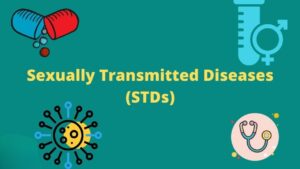
Sexually transmitted infections (STIs), also known as sexually transmitted diseases (STDs),
are infections that are spread through sexual contact. They can be caused by bacteria,
viruses, parasites, and other microorganisms. Sexually transmitted infections are a
significant public health concern worldwide, affecting millions of people each year. While
some infections may produce noticeable symptoms, others may go undetected, leading to
serious health complications. Therefore, understanding the symptoms, diagnosis,
treatment, and prevention of STIs is crucial for promoting sexual health and preventing the
spread of these infections.
Common Symptoms of Sexually Transmitted Infections:
The symptoms of sexually transmitted infections can vary depending on the type of
infection and individual factors. Some common symptoms of STIs include:
1. Genital discharge: Unusual discharge from the penis or vagina, which may be
discolored, have a foul odor, or be accompanied by itching.
2. Painful urination: Burning or discomfort while urinating can be a sign of infections
such as chlamydia, gonorrhea, or trichomoniasis.
3. Genital sores or ulcers: Painful blisters, sores, or ulcers on the genital area may
indicate infections such as herpes or syphilis.
4. Itching or irritation: Persistent itching, redness, or irritation in the genital and anal
areas could be a sign of an STI.
5. Abnormal bleeding: Unexplained bleeding between periods, after sex, or during
urination may be a symptom of an STI like pelvic inflammatory disease (PID) or
cervical infection.
It Is important to note that some sexually transmitted infections, such as chlamydia and
gonorrhea, may not cause any noticeable symptoms, especially in the early stages. In
some cases, individuals may be asymptomatic carriers of the infection, unknowingly
spreading it to their partners. Regular STI screenings and testing are essential to detect
infections early and protect both individual health and public health.
Diagnosis of Sexually Transmitted Infections:
Diagnosing sexually transmitted infections typically involves a thorough medical history
assessment, physical examination, and laboratory tests.
Some common methods used to diagnose STIs include:
1. Laboratory Tests: Urine tests, blood tests, and swab tests are commonly used
to detect the presence of STIs. These tests can identify infections such as
chlamydia, gonorrhea, syphilis, HIV, and hepatitis.
2. Pap Smear: A Pap smear is a screening test used to detect abnormal changes in
the cells of the cervix, including those caused by human papillomavirus (HPV)
infection.
3. Physical Examination: Healthcare providers may visually inspect the genital
area for signs of infection, such as genital warts, ulcers, or sores.
4. Partner Notification: It is important for individuals diagnosed with an STI to
inform their sexual partners so that they can also seek testing and treatment if
necessary.
Timely diagnosis and treatment of sexually transmitted infections are essential to prevent
the spread of the infection, manage symptoms, and reduce the risk of complications. In
some cases, untreated STIs can lead to serious health consequences, such as infertility,
chronic pelvic pain, ectopic pregnancy, and an increased risk of HIV transmission.
Treatment and Management of Sexually Transmitted Infections:
The treatment of sexually transmitted infections varies depending on the type of infection
and its severity.
Common treatment options for STIs include:
1. Antibiotics: Bacterial infections such as chlamydia, gonorrhea, and syphilis are
typically treated with antibiotics prescribed by a healthcare provider.
2. Antiviral Medications: Viral infections such as herpes, HIV, and hepatitis may
require antiviral medications to manage symptoms and reduce viral replication.
3. Antifungal Medications: Fungal infections like yeast infections can be treated
with antifungal creams or oral medications.
4. Topical Treatments: Genital warts caused by HPV can be treated with topical
medications or procedures to remove the warts.
It is important to follow the prescribed treatment regimen, as failure to do so can lead to
treatment failure, recurrent infections, and the development of antibiotic resistance.
Regular follow-up visits with a healthcare provider are recommended to monitor treatment
progress and ensure that the infection has been effectively treated.
Prevention of Sexually Transmitted Infections:
Preventing sexually transmitted infections begins with education, awareness, and
proactive steps to reduce the risk of transmission. Some key prevention strategies include:
1. Safe Sex Practices: Consistently and correctly using condoms during sexual
activity can significantly reduce the risk of STI transmission.
2. Regular Testing: Routine STI screenings are crucial for early detection and
treatment. Individuals at higher risk for STIs, such as sexually active individuals with
multiple partners, should undergo regular testing.
3. Vaccinations: Vaccines are available for certain STIs, such as HPV and hepatitis
B. Getting vaccinated can protect against these infections and their associated
health risks.
4. Open Communication: Discussing sexual health, STI prevention, and testing
with sexual partners can help facilitate informed decision-making and reduce the
risk of infection.
5. Limiting Sexual Partners: Having fewer sexual partners can lower the risk of
exposure to sexually transmitted infections.
By adopting these preventive measures and promoting awareness of sexual health,
individuals can take control of their sexual well-being and reduce the spread of sexually
transmitted infections within their communities. Remember that sexual health is an
important aspect of overall well-being, and staying informed and proactive in preventing
STIs is key to maintaining good health.
In conclusion, sexually transmitted infections are a prevalent health concern that can have
serious implications if left untreated. Understanding the symptoms, diagnosis, treatment,
and prevention of STIs is vital for safeguarding individual health and promoting public
health. By prioritizing regular testing, seeking prompt medical attention if symptoms arise,
practicing safe sex, and engaging in open communication about sexual health, we can
work together to create a safer and healthier environment for all individuals to enjoy
fulfilling and satisfying sexual relationships. Stay informed, stay healthy, and prioritize your
sexual well-being